Happy Birthday Governor Olson!
November 7 is the 135th anniversary of the birth of Culbert Levy Olson, California’s 29th governor from 1939 to 1943.
A supporter of Franklin Roosevelt’s New Deal and Upton Sinclair’s End Poverty in California, Olson advanced a progressive agenda including mandatory health insurance. The health insurance measure was rejected by the more centrist Legislature along with Olson’s proposals to raise taxes, regulate lobbyists and make the state’s prison system more humane.
His populist policies were at odds with what was then a largely Republican state. Between 1939 and 1940 five recall efforts were launched against the Democratic governor. None qualified for the ballot.
“Rich, urbane Culbert Levy Olson, elderly matinee idol of Western politics, looks like the movies’ conception of a governor. Thick, white hair sets off his handsome, ruddy face. He has the half-weary smile, the resonant, half-weary voice of an elderly statesman. He likes to dress impeccably, smoke impeccably good cigars and espouse impeccably liberal ideas,” wrote Time in September 1942.
At least one of his fellow Democrats was less charitable:
“Olson was not popular with anybody. He was pig-headed, a stubborn Swede, although he looked more like a governor than any governor we’ve ever had or ever will have,” recalled the late Sen. Ralph Dills in a 1989 oral history by the University of California.
“He’d make up his mind and you couldn’t move him at all. He was just absolutely impenetrable,” said Dills, a Gardena Democrat and EPIC supporter, who was a freshman Assemblyman when Olson became governor.
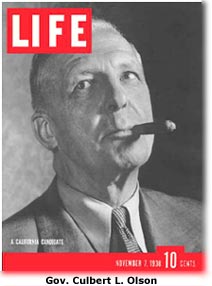 “That was his undoing, because if a legislator were with him 90 percent of the time, to Olson he was no good, because he opposed him 10 percent of the time,” said former California Supreme Court Justice Stanley Mosk, who served as Olson’s executive secretary and also started in politics with EPIC.
“That was his undoing, because if a legislator were with him 90 percent of the time, to Olson he was no good, because he opposed him 10 percent of the time,” said former California Supreme Court Justice Stanley Mosk, who served as Olson’s executive secretary and also started in politics with EPIC.
“We couldn’t deter him from having those feelings. But, as I say, it was his ultimate undoing because he never could build a big consensus, an effective consensus.”
Of his former boss, Mosk said in a 1998 oral history: “He was the most honest person I think I’ve ever known.”
A native of Utah, Olson abandoned the Mormon faith of his parents becoming an atheist at age 10. He declined to speak the phrase “so help me God” during his oath of office as governor, instead saying, “I will affirm.”
He became less circumspect about religion after leaving public life and was especially critical of the Catholic Church. Asked if he had read the Bible, Olson said:
“I don’t see how anybody can read the Bible and believe it’s the word of God or believe that it is anything but the barbarous story of a barbaric people who were so ignorant that they lived terrible lives. The Bible itself is the most obscene book that was ever published.”
Youth in Utah
Olson’s mother, Delilah was a suffragette who became the first woman elected official in Utah, serving as Millard County’s treasurer and recorder.
After a brief stint as a telegraph operator, Olson enrolled at Brigham Young University in 1890, studying law and journalism. After several years as an associate city editor for the Daily Ogden Standard, he moved to Washington D.C, working as a newspaper correspondent and a congressional secretary.
He passed the Utah bar in 1901, hanging his shingle in Salt Lake City where he met and married Kate Jeremy in 1905. They had three children.
West to Los Angeles
After four years in the Utah state Senate where he carried legislation to end child labor and guarantee pensions for retirees, Olson moved to Los Angeles, buying a home at 506 South Mariposa where he lived for 39 years.
Olson campaigned for Robert La Follette, the Progressive Party’s presidential candidate in 1924. He supported Roosevelt in 1932.
In 1934, Olson sought a state Senate seat representing Los Angeles. He allied himself with Sinclair, whose central gubernatorial campaign theme was to put Californians back to work by forming cooperatives that would take over idle factories and farms. Dills and others established EPIC clubs to promote the idea.
Sinclair lost the governor’s race to Republican Frank Merriam but Olson won his Senate seat and also became state Democratic Party chair.
Olson and Big Oil
In 1936, Olson led the opposition to Proposition 4, a ballot measure backed by Standard Oil and other oil companies to allow more slant drilling and cap royalties paid to the government at 15 percent.
To make the ballot measure seem more attractive, proponents earmarked half the royalties for the State Park Commission.
The San Francisco Chronicle was a major advocate of the initiative, routinely neglecting in its coverage to mention there was opposition to the proposal.
Ignored by the large newspapers, opponents took to the radio. Stressing beach protection and the evils of oil company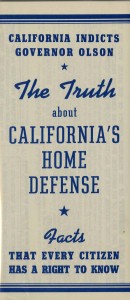 monopolies, Olson lashed out at the “unlimited expenditures” of Proposition 4 supporters on “false propaganda.”
monopolies, Olson lashed out at the “unlimited expenditures” of Proposition 4 supporters on “false propaganda.”
Both Olson and Merriam introduced rival tidelands drilling measures in 1937. Olson’s had the highest government royalties and, despite strong oil industry opposition, was eventually approved by the Legislature.
Merriam declared victory, saying the provisions mirrored his policy stance and signed the bill. Oil companies filed a referendum on the measure, effectively blocking its implementation until after the 1938 election.
Merriam was disliked by the left for his armed suppression of the 1934 Longshoreman’s Strike. His conservative base was alienated by his 1935 tax proposals to raise nearly $107 million to replenish empty state coffers.
That package included creation of the state income tax and boosting the sales tax to 3 percent.
Olson ran on a progressive platform including a pledge to pardon Tom Mooney, a labor unionist who was imprisoned for plotting a 1916 bombing in San Francisco.
Olson beat Merriam 52 percent to 44 percent becoming the first Democrat elected California governor in 44 years and the first in the 20th Century.
He pardoned Mooney.
Becoming Governor
In his January 2, 1939 inaugural address, Olson sounded the themes of his campaign:
“In the field of private industry, the right of organized labor to honest collective bargaining must be protected; minimum wages must be established and vigorously enforced to maintain a decent American standard of living; vocational training must be extended, and the doors of employment and of opportunity for advancement, through useful and meritorious service, must be opened to the eager, splendid youth of our State. Youth’s social-minded ideals, developed while in training for lifetime service, must not be shattered upon their entrance to adult life by a selfish, cold unwelcome world.”
He defended pensions to prevent California’s elderly from spending “their declining days in poverty and misery” and noted that the previous administration had left the state with a deficit of $45 million.
In a familiar pledge echoed by nearly very California governor, Olson said:
“Our efforts have been and will be to eliminate all unnecessary costs, to abolish overlapping and duplicating agencies of government and to practice every reasonable and practical economy without crippling or eliminating necessary state services.”
The First Lady
Although ill, Olson’s wife Kate attended the January 6, 1939 inaugural ball at Memorial Auditorium.
Two days later, Olson collapsed but was back on the job in a few weeks.
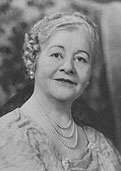 His wife Kate had a penchant for poker parties, which she held at the governor’s mansion, whose crumbling front steps Olson once fell through. The First Lady’s games, half-a-cent-per-chip, included friends and members of the governor’s security detail. One game lasted until 5:30 a.m.
His wife Kate had a penchant for poker parties, which she held at the governor’s mansion, whose crumbling front steps Olson once fell through. The First Lady’s games, half-a-cent-per-chip, included friends and members of the governor’s security detail. One game lasted until 5:30 a.m.
Asked about her influence as First Lady, she said she liked to think of herself as the “powder behind the keg.”
On April 15, 1939 she suffered three cerebral hemorrhages within a few hours and died at the mansion. She was 56. She’s the only First Lady to die while her husband was still in office.
In presenting a portrait of his wife to the state, Olson said: “It makes me very happy to know that this portrait of my lovely Kate will hang forever on the walls of the mansion she could only enjoy for so short a time.”
On her plaque at Forest Lawn in Glendale is “Tuty” whose definition is “the most elite player in the game.”
Tough Sledding in Sacramento
Besides being hobbled by his own stubbornness, Olson was saddled with a recalcitrant Legislature controlled by pro-business Republicans in the Senate and a group of 10 Democrats in the lower house calling themselves the “Economy Bloc,” who routinely sided with Republicans in opposing Olson’s agenda.
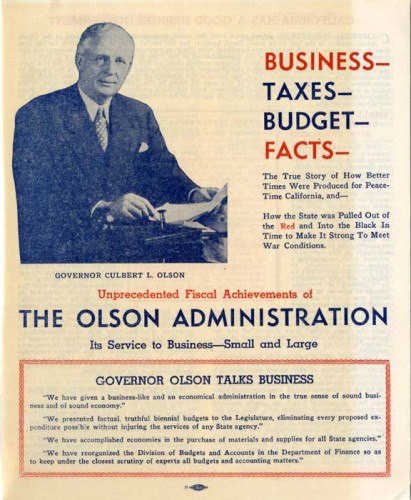 “The unhappiest, unluckiest governor of 1939” was how Time described him in a July 3 article from the same year.
“The unhappiest, unluckiest governor of 1939” was how Time described him in a July 3 article from the same year.
Time cited his wife’s death and the Legislature cutting his proposed budget by $50 million, more than halving his proposed aid to farmers from $73 million to $35 million, refusing to raise taxes, voting down the Central Valley Project despite a personal appeal from Roosevelt and rejecting Olson’s health care plan.
“It is no longer seriously debated that a fundamental change is needed in the method of meeting the costs of medical care and the risks and loss of sickness, especially for wage earners and others of small or moderate income,” Olson said in presenting the plan to lawmakers on April 13, 1939.
The plan would be paid for with equal contributions from the state, employers and employees. Employers would pay 1 percent of payroll. Employees, 1 percent of their income.
All working Californians earning $3,000 or less a year – close to $50,000 today — would have been required to be covered. Those earning more than $3,000 could voluntarily participate.
Hold the Phone
Olson had a phone line installed linking his office to the floor of the Assembly. Dills recalls then Assembly Speaker Paul Peek spending a great deal of time on the rostrum on the phone to Olson.
Then the “Economy Bloc” Democrats sided with Republicans and elected Gordon Garland, a Democrat, as speaker.
“Gordon Garland’s first act, when he was sworn in as speaker, was to go up to the podium and jerk out the telephone that Paul Peek had installed under the desk,” Dills said in his oral history.
“Garland threw it right in the middle of the aisle. He went up there and he said, ‘There will be no more phone calls either from or to the governor from this place.’ ”
It wasn’t always the Legislature thwarting Olson. After questions were raised about his alleged radical activities, the Commission on Qualifications in 1940 rejected Max Radin, a University of California Law School professor who Olson nominated to the state Supreme Court.
Olson did usher in California’s freeway age, dedicating in December 1940 the 6.7 mile Arroyo-Seco Parkway that was renamed the Pasadena Freeway and now bears its original name. The at-the-time engineering marvel reduced travel time from Pasadena to Los Angeles from 27 minutes to 12. The route looks largely the same as it did 41 years ago.
“(I)t takes courage to do a thing the first time, no matter how simple and obvious it may appear after it is done. And this, fellow citizens, is the first freeway in the West,” Olson said at the dedication. “And that is its great promise to the future, the promise of many more freeways to come.”
After the speeches, Olson and Rose Queen Sally Stanton snipped a ribbon of two garlands of roses, officially opening the $5.7 million parkway to traffic.
Of his tenure as Olson’s executive secretary, Mosk said: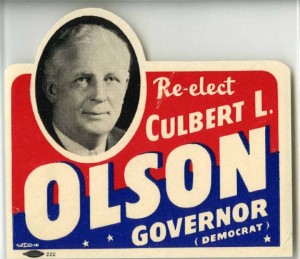
“Nowadays, governors have dozens and dozens of secretaries. In those days, a governor had only three secretaries. He had an executive secretary, an assistant secretary and a private secretary. That was his staff. So we handled everything.
“One of the secretaries handled patronage matters. I handled the legal problems: executive clemency, extradition, legislative vetoes and matters of that sort. It was a great experience. It expanded my legal knowledge, and also got me to know state government from the inside.”
After losing his re-election bid, Olson appointed Mosk to the Los Angeles Superior Court. Mosk edited Olson’s gubernatorial papers.
Church and State
Never a fan of the Catholic Church, Olson was sent two bills in 1941 sought by the church.
One gave free taxpayer-paid transportation to students attending Catholic schools. The other allowed Catholic children to leave public schools to attend catechism. While the Catholic students were gone, the other students did nothing until their return.
He signed the first bill and vetoed the second.
After Pearl Harbor, Roosevelt issued Executive Order 9066 permitting the removal of West Coast non-citizen Japanese and Japanese Americans to internment camps.
Olson supported the move. The San Francisco News on March 6, 1942 reports him telling a Congressional committee:
“Because of the extreme difficulty in distinguishing between loyal Japanese-Americans, and there are many who are loyal to this country, and those other Japanese whose loyalty is to the Mikado. I believe in the wholesale evacuation of the Japanese people from coastal California.”
Also in support was state Attorney General Earl Warren, Olson’s GOP opponent in the 1942 election.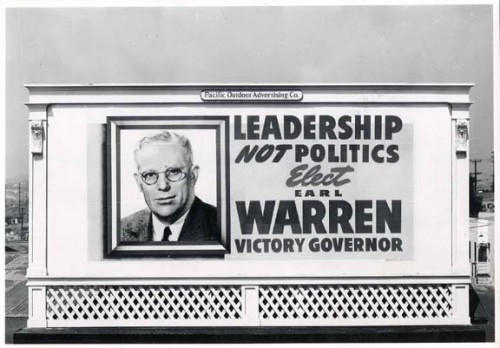
Warren traded on war fears, saying California needed to be better prepared. He portrayed himself as a centrist and Olson as embittered and intransigent.
“California is in a combat area and should be prepared to meet any emergency that may occur,” read one Warren campaign mailer.
“It is NOT prepared due to the stubbornness of your governor who will not call the Legislature together to prepare to meet these serious problems.”
Warren received 57 percent of the vote.
Olson, said Time on November 16, 1942, “can go back to his stately home in Los Angeles, where his German boxer dog Tony sits glumly on the white front porch, where the sheet music for his 1938 campaign song ‘He’s Olson’ still graces his grand piano.”
Shortly before Warren’s inauguration, Olson told his successor: “If you want to know what hell is like, just be governor.”
He returned to the practice of law and was a delegate to the Democratic National Conventions of 1944 and 1948.
In 1957, he became president of the United Secularists of America and died in Los Angeles in 1962 at the age of 85.
-30-
Filed under: California History
Capitol Cliches Conversational Currency Great Moments in Capitol History News Budget and Economy California History Demographics Fundraising Governor Legislature/Legislation Politics State Agencies
Opinionation Overheard Today's Latin Lesson
Restaurant Raconteur Spotlight Trip to Tokyo Venting Warren Buffett Welcome Words That Aren't Heard in Committee Enough

No comments yet.
RSS feed for comments on this post.